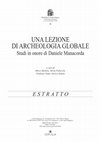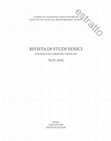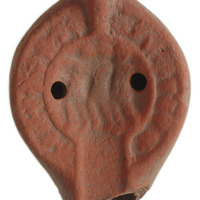Papers by Maria Letizia Gualandi

UNA LEZIONE DI ARCHEOLOGIA GLOBALE Studi in onore di Daniele Manacorda, 2019
The stripping of ancient monuments and the reuse of parts of them in new buildings with the aim o... more The stripping of ancient monuments and the reuse of parts of them in new buildings with the aim of recovering symbols of Antiquity and making them their own, is a widespread phenomenon in the Middle Ages and in the following centuries. In Pisa, however, the medieval
re-employment of roman sarcophagi for the burial of the notables of the city is a very peculiar case for the widespread use that was made between the 12th and 15th centuries. Studies starting with the Colloquium on the reuse of Roman sarcophagi in the Middle Ages (Pisa
1982) provided answers to questions such as: ʻwhy re-employment?ʼ, ʻWhen?ʼ, ʻHow?ʼ, ʻFor whom?ʼ. But there is another question, which concerns the ʻvisibilityʼ of re-employment, on which still has not been sufficiently reflected, also because most of the sarcophagi reused in Pisa, over the centuries have been removed from their original locations and moved to the monumental Camposanto: of them we know the church of origin, but rarely the exact location in it. The recent discovery of a sarcophagus reused in the 13th century in the cemetery of the church of Santa Maria Vergine - excavated in the area where today is the Palazzo della Sapienza, the seat of the University of Pisa - now provides new insights on the topic of visibility of the re-used sarcophagi, widening the known cases.
PAESAGGI URBANI TARDOANTICHI Casi a confronto, 2019
La conclusione, nel 2013, del progetto MAPPA "Metodologie Applicate alla Predittività del Potenzi... more La conclusione, nel 2013, del progetto MAPPA "Metodologie Applicate alla Predittività del Potenziale Archeologico. L’area urbana di Pisa", ha messo a disposizione in formato aperto, facilmente consultabile
da chiunque una mole di dati, processabili automaticamente, che gettano nuova luce sulle fasi romana e altromedievale della città, consentendo di seguirne le modifiche del tessuto urbanistico.
Ricerche di Storia dell'arte, 2017
The article identifies the provenance of four sarcophagi (reused as building material in two chur... more The article identifies the provenance of four sarcophagi (reused as building material in two churches on the Greek island of Skópelos) from the Assos quarries of so-called lapis sarcophagus, the ‘flesh-eating stone’ mentioned by Pliny the Elder, Naturalis Historia, XXXVI.131. This identification allows to reconstruct the export by sea of these artefacts, several examples of which were found in necropolis of the Central and Eastern Mediterranean. The island of Skópelos therefore becomes an important port in the ship’s course that between the 2nd and 3rd century AD brought the sarcophagi from the North-West Turkey until the Northern Adriatic.

“Lo mio maestro e ’l mio autore”. Studi in onore di Sandro Filippo Bondì
Archaeological research by the University of Pisa at Nora in Sardinia started at the beginning of... more Archaeological research by the University of Pisa at Nora in Sardinia started at the beginning of the 1990’s. It was focused on the district with commercial and craftsman-like characteristics, which was built in the rst half of the 1st century AD and located on the road linking the centre of the town to its port. Between the end of the 2nd and 3rd century AD the district was widely modi ed, the largest baths in the town were built, the road was paved and anked by a porch and the commercial characteristics were con rmed by the construction of a multifunctional complex called Insula A. One of the shops in the block AB was renovated: some service rooms were transformed into living rooms and organized in an apartment. It was characterized by a richness which showed the social ascent of the owner. e modi- cation of the district nds its counterpart in the redevelopment of the whole town, with a monumental restructuring of the forum, the construction of the public aqueduct and of rich domus. Imported products, especially from North Africa, also spread, proving the economic dynamism of the town during the 3rd century AD.
Tra diritti e doveri. L’Open Data nell’archeologia italiana
F. Stanco, G. Gallo (a cura di), Proceedings of Archeofoss. Free, libre and open source software e open format nei processi di ricerca archeologica, VIII edizione, Catania 2013, 2016
Volume (a cura di). Raccolta di contributi su interventi di archeologia urbana italiana direttame... more Volume (a cura di). Raccolta di contributi su interventi di archeologia urbana italiana direttamente associati alla pubblicazione di raw data come open data all'interno del repository MOD (http://www.mappaproject.org/?page_id=454)

Palaeoenvironments and palaeotopography of a multilayered city during the Etruscan and Roman periods: early interaction of fluvial processes and urban growth at Pisa (Tuscany, Italy)
A critical geoarchaeological approach, based on fully integrated archaeological, geomorphological... more A critical geoarchaeological approach, based on fully integrated archaeological, geomorphological and stratigraphic data, allowed for the identification of the palaeoenvironments, palaeotopography and urban growth patterns of Pisa (NW Italy) during the Etruscan (first half of the 5th century BC-first half of the 1st century BC) and Roman (second half of the 1st century BC-2nd century AD) periods. This powerful methodology, based on aerial and satellite images, electrical resistivity tomography, LiDAR, and core analysis, led to the reconstruction of landscape evolution, highlighting humaneenvironment interactions. During the Etruscan and Roman periods, Pisa saw a fast urban expansion in a dense and unstable fluvial network. Wide portions of the city were characterised by poorly drained conditions until the 1st century AD, when the alluvial plain became well drained under increasing anthropogenic pressure (Roman Centuriatio). Poorly drained floodplains and channel-related backswamps represent the topographically lowest zones of the ancient Pisa. This city developed within an intricate pattern of palaeochannels, related to two main rivers: the palaeoArno, which flowed in proximity of its present position, and the former palaeoSerchio river, known as Auser flowing in the northern part of the city. Since Etruscan times, a mounded relief was formed in the historical city centre of Pisa, becoming wider and more prominent (up to ca. 2 m a.s.l.) during the Roman period, concomitant with a southward rapid expansion of the urban tissue. Nevertheless, the urban growth patterns substantially followed the Etruscan city's fabric, with marked concentration of the urban structures (public and private buildings) and manufacturing sites on the northern relief, close to the Auser. The Auser River thus played a crucial role in the environmental and topographic evolution of the city area.
MapPapers 5, a cura di Francesca Anichini, Gabriele Gattiglia, M.Letizia Gualandi , Feb 2015
As the take up of new media and convergence increases, the world of communication is changing sub... more As the take up of new media and convergence increases, the world of communication is changing substantially. In this rapidly changing environment, it becomes necessary to reassess the role that media and information and communication technologies can play in engaging the public with archaeology, if, as archaeologists, we wish to communicate effectively.
Archeologia pubblica al tempo della crisi, a cura di M.Concetta Parello e M.Serena Rizzo, 2014
«Conosco un ottimo storico dell’arte...». Per Enrico Castelnuovo. Scritti di allievi e amici pisani., 2012
ArcheoFOSS. Free, Libre and Open Source Software and Open Format nei processi di ricerca archeologica, Nov 2013
metodologie applicate alla predittività del potenziale archeologico mappa
MAPPA. Metodologie Applicate alla Predittività del Potenziale Archeologico, Jun 2013
Volume II metodologie applicate alla predittività del potenziale archeologico mappa
I luoghi e le forme dei mestieri e della produzione nelle province africane, a cura di M. Milanese, P. Ruggeri, C. Vismara, Nov 2010
gli Studi di Pisa. r. Sono grata al carissimo amico Rubens D'Oriano e con lui al soprintendente F... more gli Studi di Pisa. r. Sono grata al carissimo amico Rubens D'Oriano e con lui al soprintendente Fulvia Lo Schiavo per avermi offerto la possibilità di studiare un repemo tanto singolare. 2 R. D'ONANo, Relirti li storia: Io vauo del porto di Olbia, i L'Aftica rcmana xtv, pp. 1249-62. 3. L'articolo uscirà nd volume di studi in onore di Enrico Castelnuovo, in corso di starnpa, per itipi della Scuola Normale Superiore di Pisa.
Aequora, pontos iam, mare. Mare, uomini e merci nel Mediterraneo antico. Atti del convegno internazionale, Genova 2004., 2005
Materiali per Populonia 2, 2003
Materiali per Populonia, 2002











Uploads
Papers by Maria Letizia Gualandi
re-employment of roman sarcophagi for the burial of the notables of the city is a very peculiar case for the widespread use that was made between the 12th and 15th centuries. Studies starting with the Colloquium on the reuse of Roman sarcophagi in the Middle Ages (Pisa
1982) provided answers to questions such as: ʻwhy re-employment?ʼ, ʻWhen?ʼ, ʻHow?ʼ, ʻFor whom?ʼ. But there is another question, which concerns the ʻvisibilityʼ of re-employment, on which still has not been sufficiently reflected, also because most of the sarcophagi reused in Pisa, over the centuries have been removed from their original locations and moved to the monumental Camposanto: of them we know the church of origin, but rarely the exact location in it. The recent discovery of a sarcophagus reused in the 13th century in the cemetery of the church of Santa Maria Vergine - excavated in the area where today is the Palazzo della Sapienza, the seat of the University of Pisa - now provides new insights on the topic of visibility of the re-used sarcophagi, widening the known cases.
da chiunque una mole di dati, processabili automaticamente, che gettano nuova luce sulle fasi romana e altromedievale della città, consentendo di seguirne le modifiche del tessuto urbanistico.
re-employment of roman sarcophagi for the burial of the notables of the city is a very peculiar case for the widespread use that was made between the 12th and 15th centuries. Studies starting with the Colloquium on the reuse of Roman sarcophagi in the Middle Ages (Pisa
1982) provided answers to questions such as: ʻwhy re-employment?ʼ, ʻWhen?ʼ, ʻHow?ʼ, ʻFor whom?ʼ. But there is another question, which concerns the ʻvisibilityʼ of re-employment, on which still has not been sufficiently reflected, also because most of the sarcophagi reused in Pisa, over the centuries have been removed from their original locations and moved to the monumental Camposanto: of them we know the church of origin, but rarely the exact location in it. The recent discovery of a sarcophagus reused in the 13th century in the cemetery of the church of Santa Maria Vergine - excavated in the area where today is the Palazzo della Sapienza, the seat of the University of Pisa - now provides new insights on the topic of visibility of the re-used sarcophagi, widening the known cases.
da chiunque una mole di dati, processabili automaticamente, che gettano nuova luce sulle fasi romana e altromedievale della città, consentendo di seguirne le modifiche del tessuto urbanistico.